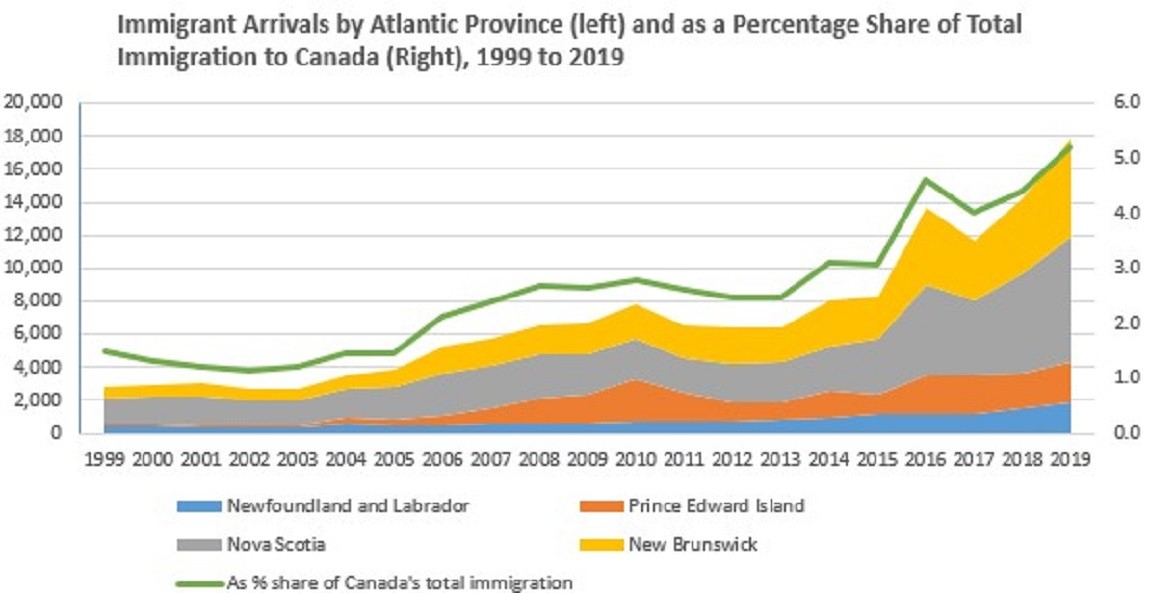Atlantic Canada is located in the eastern part of Canada, consisting of four provinces: Prince Edward Island, Nova Scotia, New Brunswick, and Newfoundland and Labrador. Due to their coastal location, the diverse natural resources, including fishing, farming, forestry and mining in the Atlantic region of Canada, make these states an important part of Canada’s history and development. Join Le Immigration to learn about the rich coastal land, along with attractive settlement policies only available in the Atlantic!
General introduction to the Atlantic region in Canada

Population and Size
The Atlantic was the first land of North America to be explored by Europeans, Canada’s four Atlantic provinces consist of a small group of islands and peninsulas on Canada’s east coast.
Occupied 5.5% of Canada’s territory, the Atlantic region has a population of 6.6% of Canada, nearly ½ of the West Coast province of British Columbia (BC), ¼ of the French-speaking region of Quebec (QB), or 1/6 of the economic leading province Ontario (ON). However the population density is still higher than the average of Canada, the world’s second-largest country. The average household income is 60,000 CAD/year, compared with the national average of 70,000 CAD/year (2018 data).
Although the population is small and economically weaker than the other provinces, the region boasts a centuries-old culture, combined with a distinct blend of British, Scotland, Gaelic and France cultures, have created the unique and very traditional Atlantic people. Most people in Canada affirm that the Atlantic region is both very strange and very interesting.
Climate
Due to the influence of the Atlantic Ocean, the climate here has cold winters and cool humid summers. The Atlantic climate is not the coldest compared to much of the domestic lands of Canada. Although there are many snowstorms in winter due to its location by the ocean, the summer is always a beautiful destination attracting tourists from all over the world.
Economy
In the past, the population of Atlantic Canada depended mostly on natural resources, including agriculture, forestry, fishery, and mining. However, the Labor Market has transformed over the past few decades from being a rural player to a workforce that relies heavily on new technology and knowledge to compete in the global market. Better-skilled workers could find new jobs, mainly in service businesses and start-ups. Many are now self-employed, bringing the Atlantic Provinces’ businesses and economies to national and international markets.
Provinces in the Atlantic region

The Atlantic consists of 4 Provinces: New Brunswick, Nova Scotia, Prince Edward Island, Newfoundland and Labrador are all different but great places to explore. Known for its picturesque beauty, this area is home to high quality of living in Canada.
New Brunswick
The Province is geographically diverse, with more than a thousand kilometers of coastline and seascapes with picturesque farmlands and unspoiled far stretching mountains. The province is bordered by Quebec and Nova Scotia as well as Maine. New Brunswick was founded by former British loyalists (United Empire Loyalists) and has the second largest river system on the Atlantic coast of North America, the St. John. Agriculture, forestry, fisheries, mining, food processing and tourism are the main industries.
New Brunswick is an officially bilingual province, with about a third of the population speaking French.
There were more than 5,000 immigrants in 2019 in the province of New Brunswick. The AIPP Atlantic Immigration Pilot Program is also helping New Brunswick set new immigration records: the province welcomed a record 4,600 newcomers in 2018, which surpassed the 5,000 newcomer mark in 2019.
Nova Scotia
Nova Scotia – the most populous province in Atlantic Canada – is rich in history as it is considered a gateway to Canada. With the highest tides in the Bay of Fundy, Nova Scotia is renowned for its shipbuilding, fishing, and shipping industries. As the largest port on the east coast of Canada with deep, ice-free water, the capital Halifax has played an important role in the long history of coal mining, forestry and agriculture. Today, it also has an offshore oil and gas exploration industry.
Its proximity to the coast has shaped the character and lives of Nova Scotia people. It offers year-round surfing, sea kayaking, wineries and markets. With a car you can easily travel to these different locations, which makes Nova Scotia a Perfect place to explore.
Nova Scotia welcomed 6,000 newcomers in 2019. Thanks to the number of immigrants through the AIPP and PNP programs, Nova Scotia set record immigration figures, surpassing the 5,000 immigrant mark for the first time in 2016. The AIPP program helped Nova Scotia reach nearly 6,000 newcomers in 2018.
- Government website of Nova Scotia.
Prince Edward Island (PEI)
It is Canada’s smallest and greenest province. Prince Edward Island (P.E.I) is famous for its beaches, red soil and rich agriculture, especially potatoes. Nestled on the waves of St. Lawrence. PEI is known for the vivid colors of the landscape, and is surrounded by miles of sandy beaches and red sandstone cliffs.
The AIPP program welcomed 235 new immigrants to Prince Edward Island in the first nine months of 2019, compared with 200 newcomers in the whole of 2018. All in all, Canada’s smallest province has the highest rate of population growth in the country. country thanks to the highest percentage of immigrants per Canadian.
- Website of Prince Edward Island.
- Website of Prince Edward Island.
Newfoundland and Labrador
Located on the eastern edge of North America, the province is the oldest colony of the British Empire. This land is made up of two parts: Newfoundland – an island in the Atlantic Ocean and Labrador located on the Canadian mainland. Honest, fun and humorous, the people here are also known for their natural creativity and knack for storytelling. With one of the lowest crime rates in North America, the province is one of the safest and most ideal places in the world to live, work and study.
Besides the natural beauty, Newfoundland and Labrador also has a unique marine heritage. It is famous for its fishing, fishing villages and its own distinct culture. Today, the offshore oil and gas drilling and production industry contributes a significant part to the economy. In Labrador, hydroelectric resources are also extremely abundant.
Both the Atlantic Immigration Pilot Program (AIPP) and the Provincial Nominee Program (PNP) accounted for 80% of Newfoundland and Labrador’s 2019 immigrants. This highlights the importance of immigration programs in supporting Newfoundland and Labrador’s efforts to promote economic development.
- Website of Newfoundland and Labrador.
Immigrating to Canada in the Atlantic Regions: What you need to know
Labor Shortage & the need to recruit immigrants
Atlantic Canada provinces have had labor shortages since before the pandemic hit and this has become more urgent after the devastation of COVID-19.
The region is also facing a population crisis with a falling birth rate and an aging population. In addition, many international students who come to study in this area tend to leave to find more job opportunities in more vibrant Provinces such as Ontario or British Columbia.
A report conducted by the Harris Center at Memorial University in Newfoundland titled “Employers Attitudes towards the Recruitment of Foreign Workers and International Students in the Atlantic Provinces.”
The results are very positive: 88% of Employers surveyed said they have a positive experience with migrant workers. They have a positive impression of immigrants because they perceive that the international workers they previously hired are hard-working, skilled and reliable.
In 2010, the Atlantic region welcomed about 3% of newcomers to Canada, despite having only 6.6% of Canada’s population. In 2016, the number of newcomers increased to 5%. The federal government of Canada launched the Atlantic Immigration Pilot program (AIPP) in 2017 as an additional tool for immigration. Since then, immigration to the area has increased dramatically. The immigration was up 22% in 2018 and up 26% in 2019.
Notable immigration targets
More than 20,000 new jobs need to be filled in cities in the four Atlantic provinces. Some jobs even bring higher income than other Canadian Provinces when working here.
Nearly 20,000 immigrants to be “recruited” to the Atlantic region is Canada’s 3 year goal of 2022-2024, through the AIPP (The Atlantic Immigration Pilot Program).
To fulfilll its plan, Atlantic Canada will need to consistently welcome more than 20,000 newcomers each year. Recently, settler retention rates are on the rise. Retaining people is critical to a positive economic growth cycle.
Immigration Canada – Atlantic Immigration Pilot Program (AIP)
- What is the AIP Canadian immigration program?
Immigration Canada AIP (Atlantic Immigration Program) is a leading economic immigration program in the Atlantic region. This is a supplement to the Provincial Nominee Programs (PNPs) for the Atlantic provinces.
The program was launched in March 2017 with the predecessor as a pilot program to assist business owners in recruiting foreign workers as well as attracting international students to study, stay and work in one of four provinces in the Atlantic region, including: Prince Edward Island, New Brunswick, Nova Scotia, and Newfoundland and Labrador.
The AIP began to gain traction in 2018. Along with other Provincial immigration programs in the region, the AIPP has contributed to bringing about 14,000 immigrants to the Atlantic region. This represents a 22% increase from the nearly 12,000 immigrants welcomed by the region in 2017.
In AIP alone, the program has granted 10,000 new permanent residents after five years of piloting. Employers participating in the AIP have issued more than 9,800 job offers in key areas including: healthcare, manufacturing, accommodation & food services.
Most notably, more than 90% of immigrants continue to live and work in the Atlantic region after 1 year. Retention rate is much higher than other programs. Because of the effectiveness of the program, on December 17, 2021, Mr. Sean Fraser – Immigration Minister of Canada officially announced to make the AIPP a permanent program, with the new name AIP (Atlantic Immigration Program).
The AIPP program had officially ended on December 31, 2021, and officially became an AIP program on February 1, 2022 with the goal of attracting about 6,000 immigrants per year. Applications that have received the Endorsement Certificate are still allowed to apply for PR until the end of March 5, 2022.

The number of immigrants in the Atlantic region has increased steadily over the years according to the statistics from the Department of Immigration.
- AIP program objectives and subgroups
The AIP program is designed based on the employer-driven immigration model to combine the needs of business owners with a pool of skilled immigrants. There is a human resource gap that some professions in Canada are facing. This is also a way to support businesses to attract immigrants to work and contribute to the economic development of the Atlantic Provinces, and opens up ideal opportunities for applicants who want to immigrate to Canada but did not meet the requirements of the Federal Skilled Worker Program (Express Entry) or the Provincial Nominee Program (PNP).
The program allows employers in Nova Scotia, New Brunswick, Newfoundland and Labrador and Prince Edward Island to hire foreign workers in areas where they cannot find local workers.
AIP is divided into 3 sub-programs:
| Program | Conditions |
| Atlantic High-Skilled Program (AHSP) – For Highly Skilled Workers |
|
| Atlantic Intermediate-Skilled Program (AISP) – For Intermediate Skilled Workers |
|
| Atlantic International Graduate Program (AIGP) – For International Graduates |
|
* List of Designated Employers:
- New Brunswick: https://www.welcomenb.ca/…/Atlantic_Immigration_Pilot…
- Nova Scotia: https://novascotiaimmigration.com/…/Designated_AIP…
- Newfoundland & Labrador: https://www.gov.nl.ca/…/atlant…/designated-employers/…
- Prince Edward Island: https://www.princeedwardisland.ca/…/atlantic…
- How AIP works
The Atlantic Immigration Pilot Program is operated primarily by government-designated employers. All AIP participants are required to have a Job Offer from a designated employer and a Settlement Plan for the applicant and their family.
Once the employer has found the right candidate for their needs and meets the requirements of the program, they will have to provide the candidate with a Job Offer Letter in accordance with the IMM 5650 form, and make sure the candidate meets the requirements. Job requirements are listed on the NOC National Occupational Classification List.
Once a candidate accepts the employment agreement, the employer must connect the candidate with a settlement service provider to assess their needs and develop a complete settlement plan. Employers have a responsibility to provide long-term support to immigrants and their families. Employers with an urgent need for additional workers will be issued Temporary Work Permits (TWPs) so that candidates and their families can come to Canada as soon as possible.
To get a Work Permit, applicants will need:
- Letter of confirmation from the province
- Commit to apply for permanent residency within 90 days of applying for a Work Permit
- Valid Job Offer from a Designated Employer. These employers must register and apply to the province and meet certain conditions.
As of June 1, 2019, the applicant’s spouse or common-law partner can apply for an open work permit if:
- The applicant holds a work permit through the Atlantic Immigration Pilot Program, and
- jobs in Skill 0, A, B, C according to the NOC National Occupational Classification List.
- Outstanding advantages of AIP:
- No requirement for a Labour Market Impact Assessment (LMIA);
- Simple language requirements (IELTS 4.0);
- Quick review time: 12-18 months;
- Receive PR for applicants and their families right in Vietnam;
- Financial proof is not required if the candidate is living in Canada and the Work Permit is valid.
Above is all the information you need to know about the Atlantic Canada region, along with the latest updated immigration policy. Should you have any questions, please feel free to contact us today at our Hotline: 0937-168-599, or visit our website: https://minhle.ca/ for advice and comprehensive support .
CONTACT INFORMATION
Address:
- 1275 Finch Avenue West, Suites 809 & 810, Toronto, Ontario, Canada M3J 0L5.
- Tầng 17, TNG Tower, 180-192 Nguyễn Công Trứ, P. Nguyễn Thái Bình, Quận 1, TP. Hồ Chí Minh.
- Hotline: 0936.168.599
- Email: info@minhle.ca












